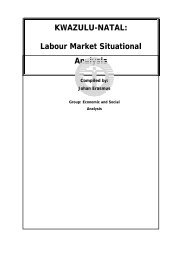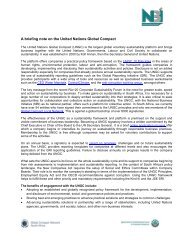Sustainable Forest Finance Toolkit - PwC
Sustainable Forest Finance Toolkit - PwC
Sustainable Forest Finance Toolkit - PwC
- No tags were found...
You also want an ePaper? Increase the reach of your titles
YUMPU automatically turns print PDFs into web optimized ePapers that Google loves.
Planted forests briefing note 1 of 6New Application HOMEWhat is the issue?‘Planted forests’ comprise all forms and scales of forestsresulting from deliberate tree planting and seeding. Plantedforests include plantation forests, planted semi-natural forests,and various forms of agroforestry. Planted forests areestablished for many purposes, including amenity,environmental services, and fuel- or industrial-woodproduction. Just over half of the world’s 270 million ha ofplanted forests are plantation forests, established forproduction or protection.Plantation forests are typically even-aged monocultures orforests of a few species of trees grown in blocks at regularspacing, although their scale and form can vary. There are140 million ha of plantation forests globally, of which nearly80% are production-orientated. The global extent ofplantation forests has been increasing by an average of 2%annually, with most new plantations being establishedprimarily for wood production. The proportion of the world’sindustrial wood sourced from plantation forests has increasedfrom negligible a century ago to more than a third today; it isexpected to continue to increase, to nearly 50% by 2040.More than 25 million ha of plantation forests are ‘intensivelymanaged’ for industrial wood production. Intensivelymanagedplanted forests (IMPF) are those of relatively highproductivity, in which the owner makes a sustainedinvestment, over the life of the forest, to optimise industrialwood production.While planted forests can clearly play a significant role insecuring the supply of industrial wood, their ability to deliverother ecosystem services such as maintaining nutrient capital,protecting watersheds, preserving soil structure and storingcarbon, is less certain and depends to a large extent onwhere they are situated and the way in which they aremanaged.Sustainability issues that need to be considered when financing forest plantations.Advantages and disadvantages of plantationsAdvantages• Can return degraded or worn-out lands to productive useand protect soil from erosion.• Can produce more wood, faster, requiring less land toproduce a specified amount of wood.• <strong>Forest</strong> plantations enable landowners to take advantageof the newest forest technology and genetics. This resultsin greater yields and better prices, strong incentives forprivate landowners to continue to practice forestry on theirlands.• Wood harvested from forest plantations is often veryuniform in terms of species and size, thereby improvingprocessing and manufacturing efficiency.• Can allow other native/natural forests to be managed forother uses, such as biodiversity, non-wood forestproducts, and aesthetics.• Greater economic value of plantations can keep forestland in forest use, where a natural forest may not beeconomically sustainable.Disadvantages• Limited biodiversity in single species plantations, resultingin reduced wildlife habitat and ecosystem value.Clearance of natural forests to establish plantationsincreases this impact.• Diseases and pests that target a particular tree speciescan have significant impacts in single species plantations.• <strong>Forest</strong> plantations often receive higher levels of inputssuch as fertilizer and chemicals to control vegetativecompetition. Run-off, overspray and groundwatercontamination can be issues if these practices are notcarried out correctly.• Some forest plantations are established using non-nativespecies. These plantations may not provide suitablehabitat for local wildlife. If allowed to escape off-site, somenon-native species may out-compete local tree species foravailable resources, and become a ‘weed’ or invasivespecies.• Rights of local communities and indigenous peoples maybe compromised. <strong>Forest</strong> plantations often take over largeareas of land that become unavailable to other users (e.g.fuel-wood collection, non-wood forest products) and candistort income distribution in households andcommunities.• Trees replacing grazing land may adversely affectgroundwater levels.Page 36pwc
















